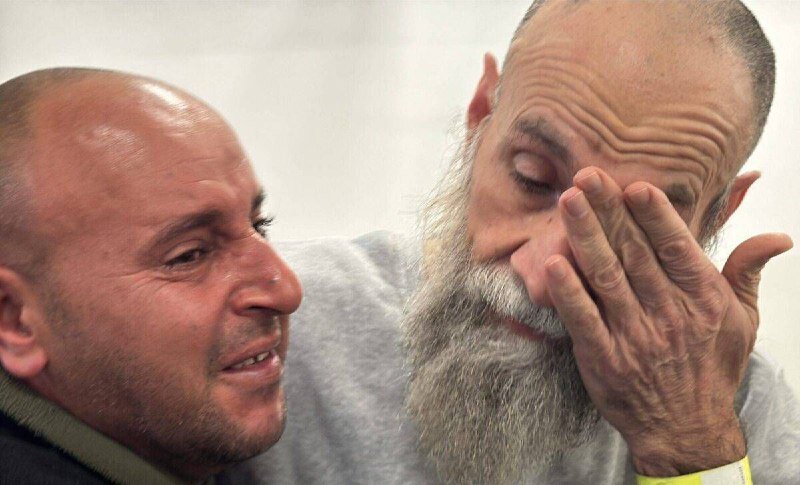Freed Palestinians Traumatic conditions exposed
Freed Palestinians: Traumatic conditions exposed
TEHRAN – The second batch of Palestinian prisoners freed from Israeli jails have shared harrowing stories of their time in Israeli prisons.

Upon their release, Israeli occupation forces also harassed them and their families, along with their supporters.
Below are some of the notable Palestinians freed by the resistance fighters in Gaza.
Mohammed al-Tous
Aged 69, he was dubbed “the dean of Palestinian prisoners” for being the longest-serving prisoner in Israeli prisons.
Al-Tous spent 39 years in Israeli jails after participating in national and resistance activities.
The veteran prisoner was first arrested in 1983 for six months after raising Palestinian flags on electricity poles in his hometown in the occupied West Bank.
His resistance activity against occupation led to his arrest again in 1985. Al-Tous was subjected to extensive periods of interrogation, during which his jailers used various types of torture methods.
Like many other prisoners, he was subjected to hanging and beating while denied medical treatment to obtain confessions, but he withstood the pressure despite enduring various forms of mistreatment.
The torment he faced, along with the loss of weight, was clear to see on his face and body in the videos that went viral following his release.
Nael Barghouti
Other reports suggest that Barghouti, 67, has spent 44 years in Israeli jails. He is the longest-serving Palestinian prisoner. Barghouti was first jailed in 1978.
Raed al-Saadi
Al-Saadi is widely believed to be the longest-serving Palestinian prisoner from the occupied West Bank city of Jenin. He was abducted and detained in 1989.
Mahmoud Shreiteh
Shreiteh was active in resistance operations as enshrined under international law.
His activism led him to become wanted by the occupation regime. His family pursued and threatened, Shreiteh’s house was raided several times, his five brothers were arrested, and his house was bombed until he was arrested in 2002.
Shreiteh was transferred to the Moscovia interrogation facility and subjected to harsh interrogation for more than three months. He was held in solitary confinement for more than 50 days. He was also deprived of visiting his family and parents.
Saeed Al-Bana
Al-Bana, 44, from Tulkarm was freed after 21 years in Israeli prisons.
In 2003, he was arrested by Israeli forces for joining the resistance against occupation. Saeed suffered from cancer while in prison and was the victim of deliberate neglect by the jailers.
Nasim al-Zaatari
Al-Zaatari was abducted in September 2003 for helping the resistance in al-Khalil, also known as Hebron in the occupied West Bank.
During his 22 years in Israeli prisons, Nasim was subjected to many punishments, faced several rounds of solitary confinement, and like many Palestinian prisoners was denied family visits.
Naji Bisharat
Bisharat was arrested in February 2002 for partaking in the anti-occupation resistance.
Israeli occupation forces abducted him after a year-long pursuit during which his family suffered from raids and continuous search of their home. During his interrogation, which lasted for more than three months, he was subjected to violent and harsh torture.
Ashraf Zughayer
Zughayer had been imprisoned since 2002 for joining the West Bank resistance forces during the second intifada.
Wael al-Jaghoub
Al-Jaghoub was arrested in 1992 and sentenced to six years in prison for his resistance against the occupation.
With the outbreak of the second Intifada, his activist role reemerged, and in May 2001, Israeli forces arrested him again and sentenced him to life imprisonment.
He was subjected to harsh and extensive periods of interrogation and solitary confinement several times.
In total, the Israeli occupation regime released 200 Palestinian prisoners in the second phase of a prisoner exchange operation as part of the ceasefire agreement, with the freed prisoners expressing gratitude to the resistance movement in Gaza.
The Palestinian Prisoners Affairs Commission and the Palestinian Prisoner Society clarified that the released prisoners in this phase included individuals serving life sentences and those with high prison terms.
However, Israeli occupation forces (IOF) physically assaulted and brutally beat up some of the Palestinian prisoners before their release.
The IOF also stormed the house of a freed Palestinian prisoner in occupied al-Quds (Jerusalem) on Saturday only a few hours after his release.
One Palestinian described the dire conditions faced by prisoners and detainees, revealing systematic abuse, starvation, and psychological warfare at the hands of jailors, especially since the October 7 al-Aqsa Storm Operation in 2023.
Al-Jaghoub described the conditions in detention as “a complete war crime, involving starvation, torture, assaults, and deprivation of medical care.”
He noted, "The occupation prevents prisoners from receiving any news, isolating them entirely from the outside world.”
According to the Prisoners’ Media Office, the IOF assaults on freed prisoners stem from their frustration over the success of the exchange deal.
The Israeli treatment of the freed prisoners stands in stark contrast to the release of Israeli captives in Gaza, who always seem in good shape.
Hebrew media acknowledged that the four Israeli female soldiers freed on Saturday in Gaza appeared in good health, stating, “There is no urgent need to transfer them to Soroka and Barzilai (hospitals); they will be taken to Beilinson (a reception center for the soldiers).”
Israeli media confirmed that the soldiers were in good condition and did not require hospitalization.
source: tehrantimes.com